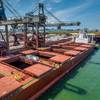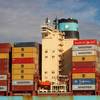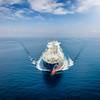Port of Rotterdam Takes Steps to Stop Delays
The Port of Rotterdam is taking measures to eliminate congestion at the ECT Delta Terminal and the Euromax Terminal. Inland waterway vessels and feeder vessels have been experiencing delays at these terminals for some time. Improvements implemented at these terminals have not had the desired effect up until now.
The inconvenience experienced by the port's customers and users is of such magnitude that the Port of Rotterdam Authority has taken the initiative of developing solutions to this problem. It became clear that all parties involved wanted to cooperate in order to improve the situation.
Three potential measures were identified pursuant to meetings with ECT, LINC (inland container shipping sector), Uniport Terminal and the Kramer Group/RCT.
Part of the inland waterway vessels, particularly those vessels transporting smaller numbers of containers to and from the port will be handled at the Rotterdam Container Terminal (RCT) located adjacent to the Delta Terminal. ECT will decide which ships will be handled by RCT. The operator will then be in direct contact with RCT. RCT will organise various related aspects, such as a berth, the unloading of containers and the overland transport to the Delta Terminal. This will unburden the water side of the Delta Terminal. This approach has since been implemented and operations can be further scaled up.
Bundling of containers in the Port of Moerdijk (M.C.T.). Inland waterway vessels with a very high capacity will subsequently shuttle between Moerdijk and the Maasvlakte. Because the cranes on larger ships can operate more efficiently, the quay at the Maasvlakte will be used more efficiently. This option is currently already available, but can be further scaled up.
Bundling of inland shipping containers, and if necessary road containers, at the Uniport Terminal in the Waalhaven area. This is similar to the bundling in Moerdijk and results in greater efficiency at the Maasvlakte. This option is currently being worked out in further detail.
The three measures are primarily focused on handling inland shipping traffic. The expectation is that this will subsequently free up quay and labour capacity in favour of sea-going vessels.
A key cause of the congestion is due to the arrival of large intercontinental container ships outside scheduled/planned times. Hundreds of hinterland movements (**) are connected with the mainland vessels, whose scheduling is consequently disrupted as well. Other ports are also faced with this problem.
(*) In addition to measures over the short term, the container sector continues to work intensively in structural handling improvements for the longer term. For example by implementing Nextlogic for the inland shipping sector.
(**) By way of illustration: a very large container ship can load and unload approximately 10,000 containers (TEU) during each call to port. On average, these containers are transported to and from the port by 1,560 trucks, 32 inland waterway vessels, 10 feeder ships (coasters) and 19 trains.













